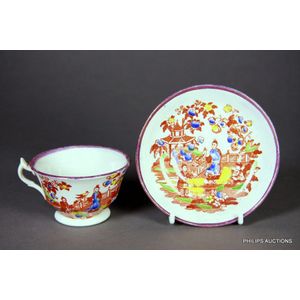Swansea Glamorgan Pottery Chinoiserie Cup & Saucer, 19th Century
You must be a subscriber, and be logged in to view price and dealer details.
Subscribe Now to view actual auction price for this item
When you subscribe, you have the option of setting the currency in which to display prices to $Au, $US, $NZ or Stg.
- Lustre Ware - Lustre decoration on ceramics is created by painting a thin deposit of metal oxide such as gold, silver or copper onto the surface, and then firing the item again, so that metal oxide forms a thin film on the surface. The finished effect is a shiny metallic surface. The technique was used in the 19th century by potteries such as Crown Devon, Grimwades, Maling, and Royal Doulton. However the best known use was by Wedgwood for its Fairyland lustre.
- Chinoiserie - Furniture and decorative items decorated in imitation of a Western interpretation of the Chinese style. The Chinoiserie style first became popular in the late 17th century, though there were frequent revivals, notably by Chippendale (hence 'Chinese Chippendale') during the Regency period, and the Anglo-Japanese style in the second half of the 19th century.
The ubiquitous 'willow pattern' is the most common 'Chinese' theme used in porcelain, while on furniture the Chinoiserie style usually has black or red painted and lacquered decoration, though the hallmark of the furniture style is the use of fretwork in geometrical patterns, pagodas and other decorative forms.
Japonaiseries, as the name implies, are motifs in imitation of the Japanese taste.
See also "Chinese Chippendale". - Pearlware - Pearlware is a type of earthenware pottery that was developed in the late 18th century in England, made from a mixture of clay, flint, and other materials, and is distinguished by its smooth, creamy white glaze. The glaze has a pearlescent quality, which is how the pottery got its name.
Pearlware was developed as a more affordable alternative to porcelain, which was much more expensive and difficult to produce. It quickly became popular throughout England and Europe, and was exported to other parts of the world as well. It was particularly popular for making tableware, such as plates, bowls, and teapots, as well as decorative objects like figurines and vases.
One of the most distinctive features of pearlware is its blue decoration. Many pieces of pearlware were decorated with blue patterns or designs, often featuring pastoral scenes, floral motifs, or geometric patterns. The blue decoration was typically applied over the white glaze, which created a striking contrast and made the designs stand out.
This item has been included into following indexes:
Visually similar items

A group of six Meissen Marcolini period cups and saucers, 1774-1814, small bowl shaped cups with foliate handles, all pieces vibrantly and individually painted with 'Deutsche Blumen', underglaze blue crossed swords and star marks underside. Height 4.5 cm.

A Dr Wall Worcester 'Chinese Family' tea bowl and saucer, circa 1770, a delightful petite bowl and conforming saucer with crow's foot red and gold borders and decorated in a polychrome palette with narrative scenes comprising pairs of male and female figur

An important Caughley cup and saucer, circa 1800, decoration attributed to William Billingsley at Mansfield, the tea cup and saucer both with octagonal reserves of flowers, the saucer with a gilt border of wheat ears and foliage and gilded rims, the cup wi

A Coalport 'Green dragon' tea cup and saucer, circa 1810, the exterior of the Bute-shape cup and the saucer with Chinese-style decoration of dragons in green enamel over a black-printed base on the white-glazed ground, the rims gilt. Height 6 cm (cup) diam
